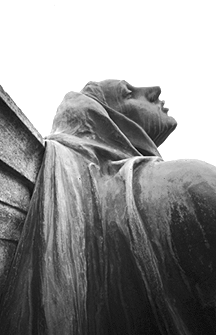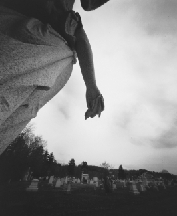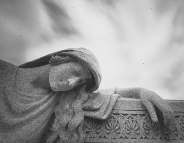| |
 Harriet's
Book Harriet's
Book
On
march 18th, 1837, a woman named Lois Gould gave her new sister-in-law,
Harriet Lazell Gould, a book of blank pages bound in cardboard covered
with ornamental, marbled paper and an embossed leather spine. Similar
books were used for diaries, recipe books, housekeeping records or household
accounts, but Lois Gould had a grander purpose in mind. In a large, bold
hand she inscribed the Örst page: Harriet Gould’s Book, Dover, Vermont,
March 18th, 1837 and went on to write the following inscription on page
three:
Should
dearest friends some kind memento trace,
Along the unwritten columns of this book
When distance or the grave hides form and face
Into this volume sweet t’will be to look.
Each fond remembrance oft will speak to you
In language which may never be forgot
Of those who ever constant were and true
And gently whisper O forget me not.
This
epigraph transforms the limitless potential of the blank book into what
it is: a keepsake album Ölled with verbal “remembrances.” More
importantly, the epigraph suggests when, how and why the book should be
used. Harriet’s Book, Lois hoped, would become a weapon in the struggle
of memory against forgetting.
Harriet and her friends turned the pages of this ordinary book to an extraordinary
use. Together they wrote down forty different poems as ‘fond remembrances’
of themselves to their friend, Harriet. Almost every page is covered with
the careful, flowing script of various hands and, tucked between the last
page and the book’s cover is a set of poems memorializing the deaths
of children. All of the poems touch on loss. All of the poems are gifts.
 Harriet Gould’s
Book, like the many albums it typiÖes, offers a view of 19th century life
that is, in many respects, inconsistent with our present view of that
time. To remember, to be remembered, meant for these earlier New Englanders,
to continue to exist for each other even across the vast distances of
time, geography, and death. I like to think of the poems in Harriet Gould’s
Book as the traces of a collaborative effort to address speciÖc threats
of loss. As children of parents who had left their parents to move to
the hill country of “New Connecticut,” and as the siblings of
men and women who would move farther west as opportunity arose or away
to the factory towns, the members of Harriet’s circle of friends
knew that voluntary bonds of affections were necessary to cement the easily
broken bonds of kinship. As parents of young children during the years
when cholera Örst moved up the Atlantic coast and stayed to pose a recurrent
summer threat, and later, as parents and siblings of men at risk of death
and privation in the Civil War, they knew how fragile the connections
were between people. They invented a tradition of collaborative mourning
that testiÖes to a belief that neither the ties of blood nor the ties
of place could be sustained without shared efforts of will. Harriet Gould’s
Book, like the many albums it typiÖes, offers a view of 19th century life
that is, in many respects, inconsistent with our present view of that
time. To remember, to be remembered, meant for these earlier New Englanders,
to continue to exist for each other even across the vast distances of
time, geography, and death. I like to think of the poems in Harriet Gould’s
Book as the traces of a collaborative effort to address speciÖc threats
of loss. As children of parents who had left their parents to move to
the hill country of “New Connecticut,” and as the siblings of
men and women who would move farther west as opportunity arose or away
to the factory towns, the members of Harriet’s circle of friends
knew that voluntary bonds of affections were necessary to cement the easily
broken bonds of kinship. As parents of young children during the years
when cholera Örst moved up the Atlantic coast and stayed to pose a recurrent
summer threat, and later, as parents and siblings of men at risk of death
and privation in the Civil War, they knew how fragile the connections
were between people. They invented a tradition of collaborative mourning
that testiÖes to a belief that neither the ties of blood nor the ties
of place could be sustained without shared efforts of will.
A nostalgic view of the past conveniently allows us to see our present
moment as one of decline from the glory of the ‘good old days’
of stable homes and happy families. But these poems insist upon the omnipresence
of loss and dislocation while offering a promise or a hope that the lost
will be found. Because we, Americans and Vermonters, tend to picture the
past as a time of utopian fulÖllment, the expressions of anxiety, fear
and loss contained in much antebellum poetry have tended to be read and
dismissed as suspect or inauthentic when accompanied, as these tend to
be, by claims of solace or resignation. Literary anthologies and literary
histories scorn the kind of poetry written in Harriet’s Book and
by the mid-20th-century it had come to be regarded as inconsequential
to the history of American culture. I have found, however, that it had
once been tremendously common and respected. How could this poetry be
inconsequential if it had meant so much to so many? Could the mourning
of so many mothers for their children, so many sisters for their brothers,
so many wives for their friends be without consequence to American culture?
These poems are only one part of a larger effort to imagine continuity
and stability in the midst of a culture of sometimes threatening change.
Paper, stone, and even hair could be turned into vehicles for the circulation
of memory that acted as the lifeblood of the community. The poems of Harriet
Gould’s Book, especially the infant elegies, correlate strongly with
the gravestones found in the cemeteries of East and West Dover, Vermont.
Like the poems, the inscriptions on the stones attempt to link the living
to the dead. “How we miss thee Lucian/ Words can never tell”
reads the grave of one of Harriet’s nephews, despite the fact that
his mother (Abigail Gould Howe) did try to tell how much she missed him
in a poem testifying to the difÖculty of reconciling herself to his death.
In a related gesture, an unknown woman of Harriet’s community wove
the hair of her friends and family into an arrangement of flowers that
she placed in a gilded shadowbox to deny the present fact of death by
preserving the past for the future. Like the poems of Harriet’s Book
and the stones of the local graveyard, the intricate pattern of variously
colored swirls and knots of hair converts the horrible into the beautiful,
transforms the dead into the living, through a tremendous effort of imagination
and skill.
 It might, now,
be difÖcult for us to even recognize such artifacts for what they are
when we come across them. We might be drawn to the aura of the past surrounding
the gravestones of rural cemeteries, the dust of the covers and frames
of old objects, but be unable to understand what is being said. Though
we hear the gentle whisper, “O forget me not,” are we able to
remember much about Harriet or Lois or their children? Except for a few
tantalizing fragments, the language they are speaking has been erased
from the cultural memories of America leaving us to struggle, not to remember,
but to imagine. VQ It might, now,
be difÖcult for us to even recognize such artifacts for what they are
when we come across them. We might be drawn to the aura of the past surrounding
the gravestones of rural cemeteries, the dust of the covers and frames
of old objects, but be unable to understand what is being said. Though
we hear the gentle whisper, “O forget me not,” are we able to
remember much about Harriet or Lois or their children? Except for a few
tantalizing fragments, the language they are speaking has been erased
from the cultural memories of America leaving us to struggle, not to remember,
but to imagine. VQ
—English professor and alumna (’86) Mary Louise Kete’s
book Sentimental Collaborations: Mourning and Middle-class Identity in
19th-century America was published last year by Duke University Press.
She dedicates this article to the memory of Mr. and Mrs. Ralph Wesley
Howe, Jr. whose love and generosity have made so much possible.
|


